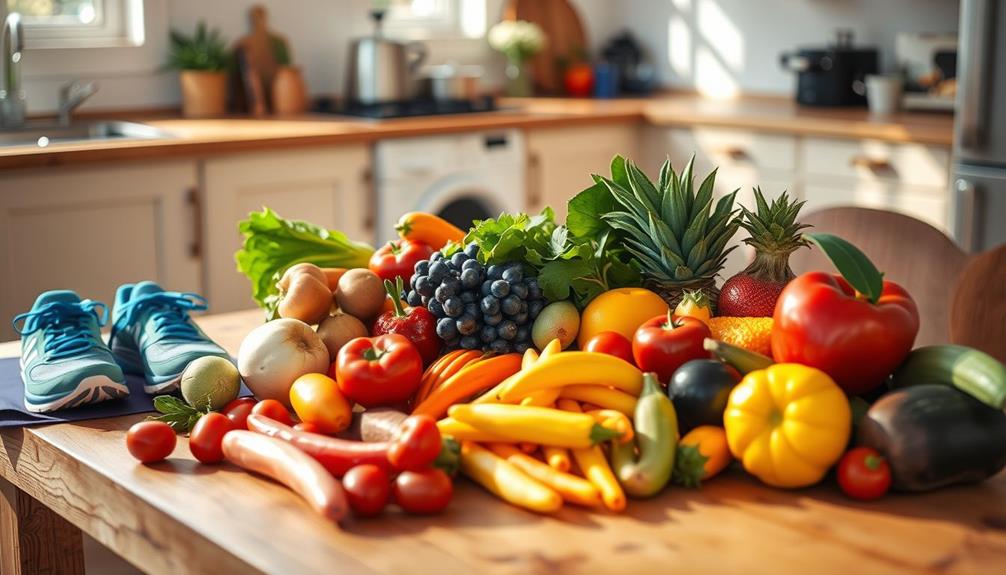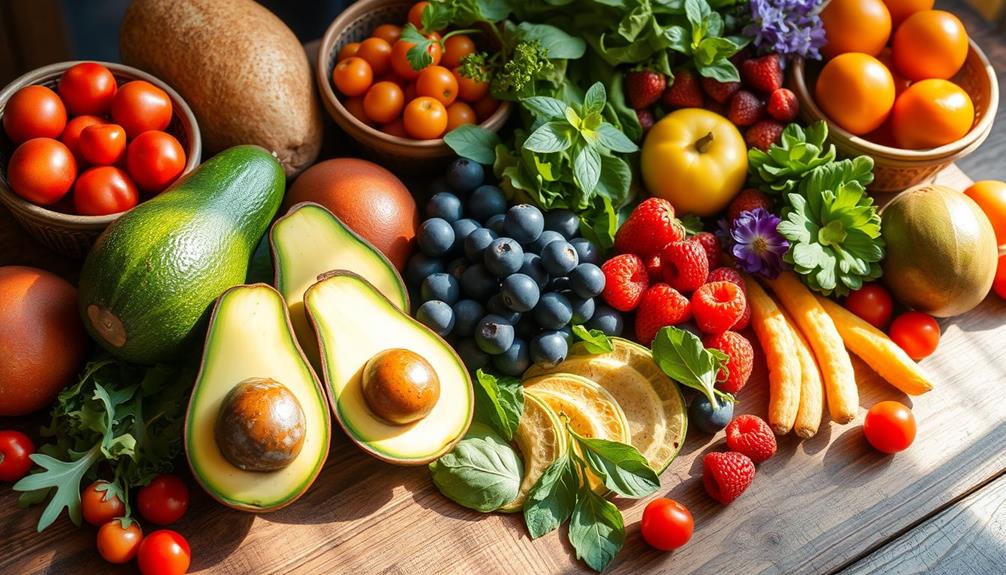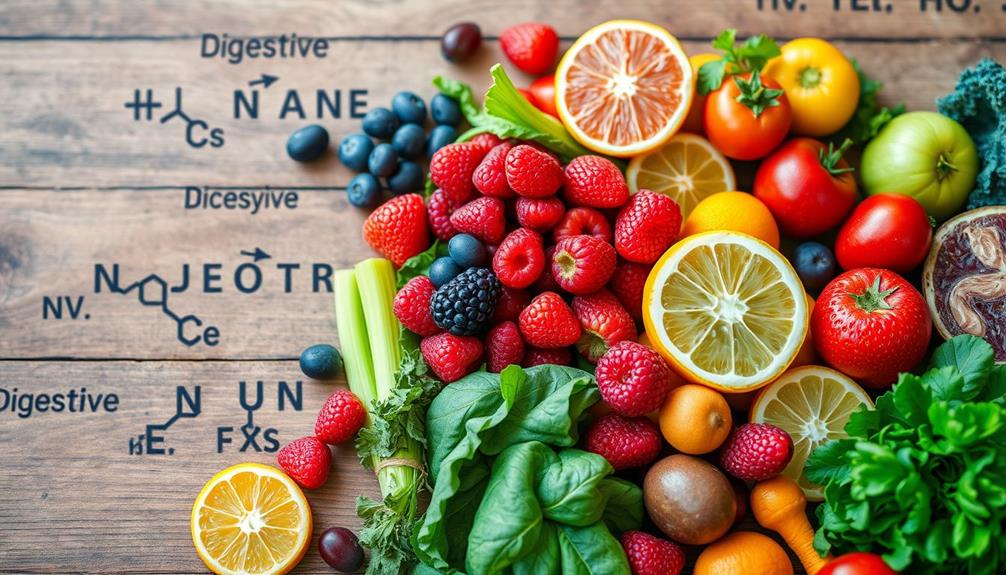The Raw Food Diet can indeed encourage exercise by providing a nutrient-rich source of energy that boosts your workout performance. Foods like raw fruits, vegetables, nuts, and seeds fuel your body while promoting muscle repair and recovery. However, it's vital to maintain a balanced diet to avoid nutrient deficiencies that could sap your energy and motivation. Regular exercise remains important for maximizing health benefits, as diet alone won't keep you fit. Incorporating mindful activities can enhance your overall well-being and performance. If you're curious about how to blend these elements effectively, there's much more to discover.
Key Takeaways
- The raw food diet emphasizes nutrient-dense foods that can boost energy levels, potentially encouraging more physical activity.
- High fiber content in raw foods promotes satiety, which may support sustained energy during workouts.
- Regular exercise is essential to maximize the health benefits of a raw food diet, as diet alone is insufficient for fitness.
- Low-calorie intake and nutrient deficiencies in a raw food diet can lead to fatigue, impacting motivation for exercise.
- Incorporating a balanced diet with raw food choices helps prevent nutrient deficiencies, supporting both energy levels and exercise efficiency.
Understanding the Raw Food Diet
The raw food diet centers around the idea of eating unprocessed, whole foods that are rich in nutrients. This diet primarily consists of raw fruits and vegetables, nuts, seeds, and sprouted grains, while avoiding cooked, processed, and non-organic foods.
You'll find that foods consumed on this diet mustn't be heated above 104-118°F (40-48°C) to preserve their nutrients and enzymes, which leads to preparation methods like juicing, blending, and dehydrating. Consuming nutrient-dense foods, such as celery juice, may enhance overall health and hydration levels, making it a popular choice among raw food enthusiasts beneficial for overall health.
One popular variation is the raw vegan diet, which excludes all animal products. Advocates tout several health benefits, including increased energy levels, weight loss, improved skin health, and a lower risk of chronic diseases due to the diet's high nutrient density.
However, it's important to be aware of potential risks. The raw food diet can lead to nutrient deficiencies, particularly in protein and vitamin B12, and it may expose you to foodborne illnesses, especially from raw animal products.
Exercise Benefits of Raw Foods

When you embrace a raw food diet, you tap into a wealth of nutrients that can markedly boost your energy levels during workouts.
The high vitamin and mineral content found in fresh fruits and vegetables helps enhance your overall performance.
Additionally, incorporating natural remedies alongside conventional medications can further support your health and exercise regimen.
Nutrient Density Advantage
Nutrient density plays an essential role in enhancing your exercise performance and recovery, especially when it comes to a raw food diet. Raw foods are packed with important vitamins, minerals, and antioxidants that can greatly boost your physical activity.
The incorporation of a balanced diet rich in fruits and vegetables complements the benefits of raw foods, promoting overall health. The high fiber content in these nutrient-dense foods promotes satiety, helping you feel full while maintaining steady energy levels during workouts, which can improve your endurance and overall exercise efficiency.
Incorporating raw foods, like nuts and seeds, into your meals provides healthy fats and proteins necessary for muscle repair and growth, making them ideal if you're into strength training.
Plus, consuming raw foods often results in a lower overall calorie intake while still supplying the necessary nutrients to fuel your physical activities. This balance can aid in weight management, allowing you to achieve your fitness goals more effectively.
Don't forget the hydration factor—many raw fruits and vegetables have high water content, which helps maintain excellent hydration status. Staying hydrated is important for maximizing your exercise performance and recovery, ensuring you get the most out of your workout sessions.
Enhanced Energy Levels
Experiencing increased energy levels is a common benefit for those following a raw food diet. This diet emphasizes nutrient-dense fruits and vegetables, loaded with essential vitamins and minerals that fuel your body for ideal function.
By incorporating practices such as gentle stretching before bedtime, you can further enhance your energy levels and overall well-being. The high fiber content in these foods not only promotes satiety but also helps maintain sustained energy levels, making it easier to engage in regular physical activity.
Raw foods are rich in enzymes, which some believe aid digestion, potentially revealing greater energy availability for your workouts and daily activities.
As you consume more whole plant foods, you might notice improved stamina and quicker recovery times after exercise. Anecdotal evidence suggests that individuals on a raw food diet often report enhanced performance, allowing them to push harder during workouts.
Nutritional Balance and Energy Levels
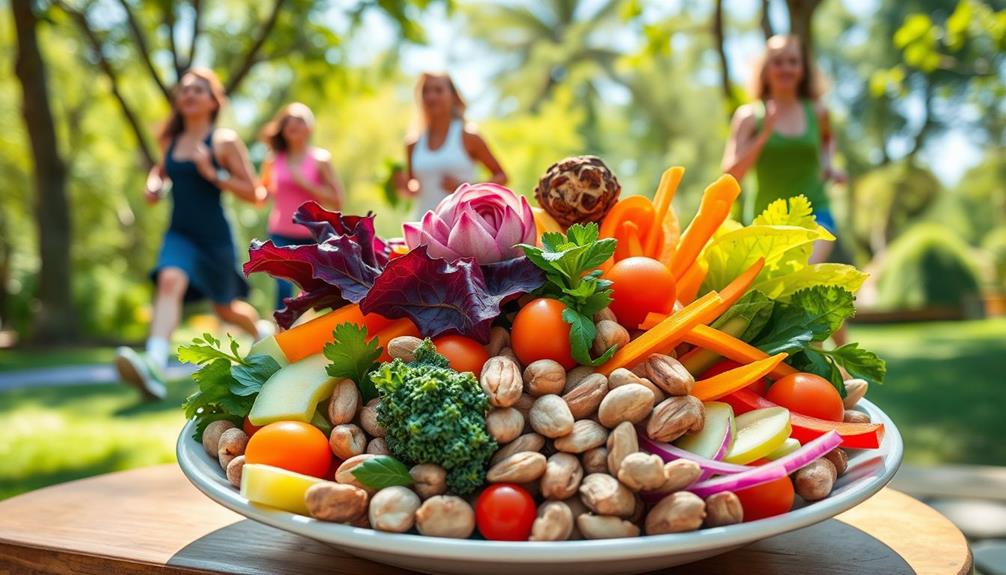
A well-balanced raw food diet can greatly impact your energy levels and overall motivation to exercise. By focusing on raw fruits and vegetables, you're likely to consume essential vitamins and minerals that support energy metabolism. This can enhance your physical activity and help you feel more energized throughout the day.
Additionally, incorporating natural supplements like essential oils may provide additional health benefits and support your exercise routine, such as essential oils for respiratory health. However, it's vital to confirm you're not experiencing nutritional deficiencies, particularly in protein, vitamin B12, and iron, as these can lead to reduced energy levels and affect your desire to work out.
When you maintain balanced nutrition, you may notice improved weight loss and muscle tone, especially if you incorporate regular exercise into your routine. Many individuals on a raw food diet report increased energy levels, which often translates to a greater willingness to engage in physical activity.
While exercise isn't mandatory on the raw food diet, keeping your energy levels up through a well-rounded approach to nutrition can definitely enhance the benefits of your diet. Ultimately, achieving peak energy levels through a raw food diet can motivate you to stay active and prioritize your overall health.
Common Misconceptions About Exercise
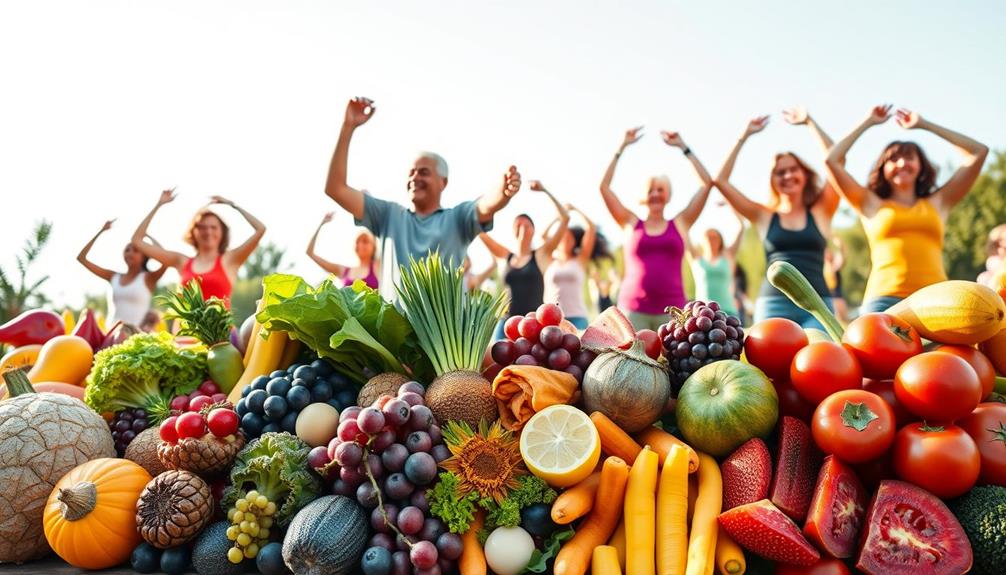
You might think that eating a raw food diet automatically boosts your exercise routine, but that's not always the case. While raw foods can provide essential nutrients for energy and recovery, a diet solely consisting of raw foods may not provide enough calories to support a rigorous exercise routine. It’s important to find a balance between a raw food diet and exercise to ensure that your body is getting the fuel it needs to perform at its best. Incorporating cooked foods, healthy fats, and protein sources can help supplement a raw food diet and support your exercise goals.
While fresh foods can support an active lifestyle, they don't guarantee you'll have the energy or nutrients needed for ideal performance.
For instance, understanding your body's nutritional requirements is essential when planning meals, just as setting specific savings goals is critical for financial health.
It's essential to recognize that integrating exercise with your diet requires careful planning and attention to your body's needs.
Exercise Importance in Diet
Many people mistakenly believe that following a raw food diet alone guarantees weight loss and improved health. While eating uncooked foods can be beneficial, it's essential to understand that diet alone isn't enough.
Developmental growth, both physical and emotional, is influenced by key domains of development that include environmental interactions and lifestyle choices. Here are some common misconceptions about the relationship between exercise and diet:
- Weight loss requires more than just dietary changes.
- Metabolic health improves considerably with regular physical activity.
- Mental health benefits from the endorphins released during exercise.
- Cardiovascular fitness is supported by a combination of diet and exercise.
Research shows that combining a healthy raw food diet with regular exercise yields better health outcomes than relying on diet alone. Without physical activity, you mightn't fully enjoy the potential benefits of your raw food choices.
Exercise enhances your metabolic health, contributes to weight loss, and boosts your overall well-being.
Incorporating exercise into your routine not only supports weight management but also strengthens your muscles and improves cardiovascular fitness.
Energy Levels and Activity
Energy levels and activity often go hand in hand, but misconceptions about the raw food diet can cloud the relationship between nutrition and exercise. Many advocates claim that the nutrient-dense fruits and vegetables found in a raw food diet can boost your energy levels, encouraging you to engage in more physical activity.
Furthermore, understanding how different diets can affect overall well-being is vital; for instance, studies highlight the positive impact of a diet rich in fruits and vegetables on physical performance, similar to how various brewing methods affect caffeine content considerably. You might find that you feel more alert and energetic, which could lead to a greater desire to exercise compared to those on a standard diet.
However, it's important to recognize the low-calorie nature of this diet, which can sometimes lead to fatigue and decreased stamina. For some individuals, this drop in energy can make consistent exercise a challenge.
While studies suggest that diets rich in fruits and vegetables can enhance overall physical performance, not every raw food enthusiast experiences this boost.
Lifestyle Integration Challenges
While a raw food diet can offer numerous health benefits, it's a common misconception that it alone suffices for maintaining physical fitness. Many people believe that simply eating raw foods will lead to weight loss and improved energy levels, but neglecting physical activity can undermine these benefits.
Additionally, just as AI Ethicist Jobs shape the moral framework of technology, understanding the importance of exercise in a healthy lifestyle is vital. Here are some key points to reflect on:
- A raw food diet doesn't explicitly require exercise for health gains.
- High energy levels from raw foods may not automatically translate to increased activity.
- Regular exercise considerably enhances overall well-being and fitness.
- A sedentary lifestyle can counteract the advantages of a raw food diet.
Incorporating regular physical activity is essential for cardiovascular health, muscle maintenance, and achieving sustainable weight loss.
If you rely solely on diet without exercise, you might find yourself stuck in a sedentary lifestyle, which can diminish the positive effects of your raw food choices.
To truly thrive, combine your raw food diet with consistent exercise that fits your lifestyle. This way, you'll maximize your health benefits, maintain energy levels, and ultimately improve your overall well-being.
Don't underestimate the power of movement!
Recommended Exercise Regimens

Incorporating exercise into your raw food diet can greatly enhance your health journey. While the diet itself doesn't require physical activity, adding exercise can markedly boost weight loss and overall wellness. Studies suggest a correlation between astrological signs and perceived beauty, highlighting the importance of self-image and confidence, which can be positively impacted by regular physical activity.
Aim for at least 150 minutes of moderate-intensity exercise each week to support your cardiovascular health and maintain a balanced lifestyle.
Start with low-impact activities like walking or yoga, which are perfect for complementing the low-calorie nature of your raw food diet. These activities not only improve flexibility and mental clarity but also help in managing stress.
If you're looking for a bit more intensity, consider cross-training or cycling to keep things interesting.
Don't forget about strength training! Incorporating bodyweight workouts or resistance training is essential for preserving muscle mass while you enjoy your raw food diet.
Regular physical activity combined with mindful practices, such as gentle stretching and breathing exercises, can enhance your overall balance and well-being. By creating a well-rounded exercise regimen, you'll experience the full benefits of your raw food lifestyle, leading to improved energy levels and health outcomes.
Challenges in Maintaining Energy

Maintaining your energy levels on a raw food diet can prove to be a challenge. While this diet emphasizes fresh, nutrient-dense foods, you may experience some hurdles that affect your overall vigor and exercise performance:
- Low-calorie intake can lead to fatigue.
- Nutrient deficiencies, especially in iron and protein, may hinder your energy.
- High fiber content can cause digestive discomfort, like bloating and gas.
- Initial lethargy during the shift often diminishes motivation.
These factors can make it tough to stay active and engaged in regular exercise. You might find that your energy dips, impacting not just your workout routine but also your overall mood.
To combat this, it's essential to focus on a diverse range of nutrient-dense foods that deliver important vitamins and minerals. Incorporating more protein-rich options and considering supplements can help address potential nutrient deficiencies.
Tips for Combining Diet and Fitness

Finding the right balance between your raw food diet and fitness routine can greatly enhance your overall well-being. To maximize the benefits of your diet, aim to incorporate regular exercise into your schedule. Moderate activities like yoga or brisk walking can complement the high energy levels you'll experience from the nutrient-rich foods you're consuming.
The high fiber content of the raw food diet not only aids digestion but also provides sustained energy for your workouts, making it easier to maintain an active lifestyle. To support your fitness regimen, consider timing your meals around your workouts to optimize energy levels and performance.
It's essential to maintain a balanced diet alongside your raw food choices to prevent nutrient deficiencies. Pairing your diet with consistent exercise can help mitigate these concerns while promoting overall health and metabolic function.
Additionally, an active lifestyle can improve cardiovascular health and support weight loss, reducing the risks of chronic diseases.
Frequently Asked Questions
Does the Raw Food Diet Recommend Exercise?
The raw food diet doesn't explicitly recommend exercise, but you might find that increased energy from raw foods inspires you to stay active. Ultimately, it's up to you to decide how much exercise to incorporate. If you’re looking to combine raw food with a specific cultural tradition, consider exploring Korean raw food traditions, which emphasize fresh and minimally processed ingredients such as vegetables, fruits, and fermented foods. These traditions also value balance and harmony in food preparation, which can have a positive impact on your overall well-being. Whether you choose to include exercise or explore new culinary traditions, the raw food diet allows for flexibility and personalization to fit your individual lifestyle and goals.
What Does the Raw Food Diet Promote?
The Raw Food Diet promotes vibrant health through unprocessed foods while contrasting with typical diets laden with additives. You'll savor raw fruits, vegetables, nuts, and seeds, maximizing nutrients and potentially boosting your energy and digestion.
What Happens to Your Body on a Raw Food Diet?
On a raw food diet, you might notice improved digestion, weight loss, and better energy levels. However, you could also face temporary digestive discomfort and potential nutrient deficiencies due to the absence of cooked foods in your meals.
What Do Doctors Say About the Raw Food Diet?
Doctors express doubts about the raw food diet's nutritional drawbacks, like potential protein and vitamin deficiencies. They often recommend a balanced approach, blending raw and cooked foods for better health and overall nutrient absorption.
Conclusion
Incorporating a raw food diet into your lifestyle can spark a vibrant dance of energy and liveliness, encouraging you to move more. Embrace the fresh flavors and nutrients that fuel your body, pushing you to explore new exercise routines. While challenges may arise, think of them as stepping stones on your path to wellness. By harmonizing your diet and fitness, you'll find yourself blossoming into a healthier, more active version of yourself. So, let the journey begin!

